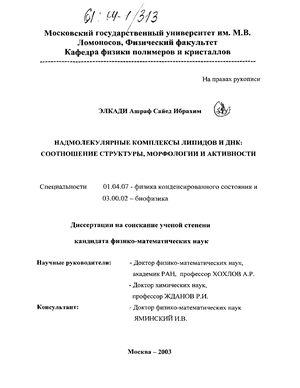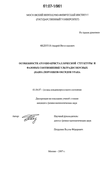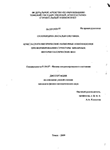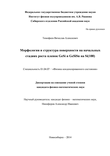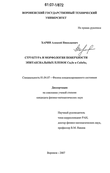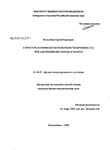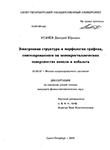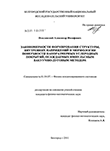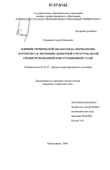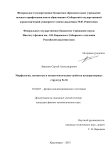Содержание к диссертации
Введение
Chapter I. Literature Review
1.1 Theoretical description of DNA 11
1.1.1 Statistical Thermodynamic Models and Molecular Dynamics 11
1.1.2 Polyelectrolyte Models 13
1.2 DNA condensation 22
1.3 Examples of DNA condensing agents 24
1.4 Morphology of condensed particles 28
1.5 Mechanism of condensation 30
1.6 Structure of condensed DNA 32
1.7 Intermolecular forces involved in condensation 34
1.8 Biological significance of condensation 37
1.9 DNA-lipid complexes as a non-viral gene delivery systems 38
Chapter II Materials and methods
II.1. Materials and samples preparation 56
II.2. Physical and biophysical approaches 60
Chapter III Results and discussions
III. 1. Structure of DNA/Dicationic Lipid Complex as revealed by Coherent Phase and Atomic Force Microscopy 72
Ш.2. The Structural-Activity Relationships for Lipoplexes Prepared from a Newly Synthesized Dicationic Lipid and plasmid DNA 85
Ш.З. Tailoring DNA condenstaes using a dicationic lipid with different spacers 94
1ГІ.4. Structural and Morphological Peculiarities of DNA-Vitamin D complexes: A Fluorescence and Atomic Force Microscopy Study 107
Ш.5 A Spectroscopic and Atomic Force Microscopy Study for Oleic 115
Concluding remarks 129
References 132
- DNA condensation
- Biological significance of condensation
- Physical and biophysical approaches
- The Structural-Activity Relationships for Lipoplexes Prepared from a Newly Synthesized Dicationic Lipid and plasmid DNA
Введение к работе
I d like to thank and acknowledge those whose encouragements and support were indispensable in the completion of this dissertation. With a feeling of accomplishment and honor, that 1 have had the privilege of working with a distinguished scientist over the last three years: Prof. Dr. Acad. A. R. Khokhlov, my supervisor who has given me wide latitude and freedom in the research problems that are presented here. I d like also to express my gratitude to my co-supervisor Prof. Dr. R. I Zhdanov who was not only my co-supervisor but a kind friend as well. Their approach to science and research, J assume, will stay with me throughout my career. I thank Dr. I. V. Yaminsky who introduced me to the field of scanning force microscopy and gave me access to his labs. I also want to thank Dr. E. E. Makhaeva for guesting me in her laboratory and for her valiable advices and useful comments during the work; Dr. Tatiana Laptinskaya, for her patience and guidance during preparation of formal documents. I also benifitted from cooperation with Dr.Y.Livovich, Dr.S.Abramtchuk, Prof V. Tychinski, Dr. T. Vyshenskaya. Special thanks to Dr. Gerlinde Bischoff for the spectroscopic measurements and Alexei Moskovtsev for his assistance in experiments with cultured cells. I also acknowlege Dr.Y.Yermakov for surface potential measurements and for his thoughtful comments and explanations.
Introduction
7. Motivation for the work
The last decade has witnessed a rapid and continuing development in the field of of polymer science which resulted in applications well beyond the scope of physics and chemistry, and in order to solve complex problems, this science has had to combine its efforts with many other sciences, e.g. molecular biology, biotechnology and nanomedicine.
Molecular self-assembly presents a rbottom-up approach to the fabrication of objects specified with nanometre precision. DNA molecular structures and intermolecular interactions are particularly amenable to the design and synthesis of complex molecular objects (1). Particularly, the self-assembly of amphophilic molecules constitute one of the most fundamental mechanisms for the construction of soft condensed matter biomaterials (2). It is, however, well known that lipids, as well as mixtures of anionic and cationic single chain surfactants, can readily form bilayers (3, 4) that can adopt a variety of distinct geometric forms: they can fold into soft vesicles or random bilayers (the so-called sponge phase) or form ordered stacks of flat or undulating membranes (5).
2. Aims and scope of the study
In the present work we investigated nucleic acids-lipid complexes, and their applications in vitro transfection and gene expression in human cancerous cells. We emphasized on the physico-chemical and biophysical characterization of the DNA-lipid complexes, and structure-activity relationships. The main goals of the work are:
1. The physico-chemical characterization of the complexes, and structure activity relationships.
2. Studying the self-assembly of DNA with a newly synthesized dicationic lipid with different analogues (DEGA), as well as neutral lipids (vitamin D and oleic acid).
3. To bring these increasingly complex molecular systems within the scope of detailed structural studies and identify the effect of lipid structure on the interaction with DNA and morphology of the resulting self-assebled complexes.
4. Identification of the key parameters that are crucial for optimising gene transfer by correlating the structural features to transfection efficiencies.
3. Scientific findings
1. A novel approach for controlling the size and morphology of DNA condensates, using a dicationic lipid (DCL) with several different analogues, is introduced. 2. The potential of liposomes, prepared from the DCL, for delivering pEGFP-N1 DNA into eukaryodc cells was examined by monitoring gene expression in different cultured cell lines, e.g. MCF-7, SKOV-3 and 239 cells. It was found that lipoplexes composed from DCL with short spacers showed high transfectvon efficiency compared to those with long spacers.
3. To the first time, the self-assembly of phage T4 and plasmid DNA with vitamin D group, was examined in diluted aqueous solutions, in the absence and presence of Ca2+ cations, using Fluorescence and Atomic Force Microscopy. A simple method for preparing DNA-Vitamin D complex in the existence of divalent cations is introduced. The complex structure ranged from amorphous aggregates; beads-on-strings to compact single and multiple globules (0.1-1 urn), depending on vitamin nature, Ca2+ concentration and incubation time. A nucleation mechanism and flower-like aggregates are proposed as an initial state for complex formation. A new approach for targeted gene delivery (vitafection), using lipophilic vitamins (A, D, E, and K), is presented.
4. It was found that oleic acid shows molecular recognition to AT b.p. motifs by groove binding. GC tracts - in particular alternating d[G-C] motifs - are strongly influenced by ligand interaction up to a ratio of one molecule per two base pairs. The estimated amount of tightly bound oleic acid molecules is one molecule per 2-3 base pairs. As consequence, a new mechanism of regulation of gene expression at nuclear membrane or by lipids inside DNA double helix is introduced.
DNA condensation
DNA condensation has become a lively area for research in diverse areas of science. In biochemistry, biophysics, and molecular biology it represents a process by which the genetic information is packaged and protected. In polymer physics and condensed matter physics, it presents intriguing problems of phase transitions, liquid crystal behavior, and polyelectrolytes. Besides, in biotechnology and medicine, it provides a promising means whereby DNA containing genes of therapeutic interest can be prepared for transfer from solution to target cells for gene therapy applications. DNA condensation could be defined as the collapse of extended DNA chains into compact, orderly particles containing only one or a few molecules. The decrease in size of the DNA domain is striking, as is the characteristic toroidal morphology of the condensed particle, so the phenomenon of DNA condensation has drawn considerable attention. Genomic DNA is a very long molecule, which must fit into a very small space inside a cell or virus particle. Fully extended, the 160,000 base pairs of T4 phage DNA span 54 urn. Yet the T4 DNA molecule has to fit in a virus capsid about 100 nm in diameter, a 540-fold linear compression. The 4.2 million base pairs of the E. coli chromosome extend 1.4 mm (half this as a fully-stretched circular chromosome), yet must fit into a nucleolar region about 1 \xm across, a linear compression of about 1400. Thinking about the issue in a different way, the radius of gyration of the T4 wormlike coil is about 950 nm, so its volume compression ratio is about 6900. The molecular volume of the T4 DNA molecule, considered as a cylinder 2 nm in diameter phosphateo-phosphate, is 1.7 x 105 nm3; the internal volume of the capsid is about 5 x 105 nm3, so the DNA occupies about 1/3 of the volume within the capsid. If a 0.3 nm shell of ater is added to the
DNA surface, the fractional volume occupancy rises to about 1/2 (17) Considering the obvious energetic barriers to such tight packaging - the loss of configurational entropy of the long DNA molecule, the tight bending of the stiff double helix, the electrostatic repulsion of the negatively charged DNA phosphates - it is no surprise that organisms expend considerable metabolic energy to accomplish the task. Recent estimates run about 172 ATP hydrolyzed per base pair packaged (18, 19). Thus it is a considerable surprise that DNA collapse, or condensation, can occur spontaneously in the test tube, upon adding a low concentration of multivalent cation to low ionic strength aqueous buffer (20). Even more surprising, the morphology of the condensed DNA particles is most commonly that of a compact, orderly toroid, strongly reminiscent of the structure of intraphage DNA gently lysed from virus capsids (21). X-ray scattering shows that the surfaceo-surface spacing between DNA helices is only about 1-2 water diameters (22), so that the packing Chemical agents cause condensation by modifying electrostatic interactions between DNA segments, by modifying DNA-solvent interactions, by excluding volume to the worm-like coil, by causing localized bending or distortion of helical structure, or by some combination of these effects. Early studies indicated that in aqueous solutions at room temperature, a cation valence of +3 or greater is necessary to cause condensation (e.g. the naturally occurring polyamines spermidine and spermine and the inorganic cation Co(NH3)6 3+ , polylysine, and basic histones). However, recent results (23) show that Mn2+ can produce toroidal condensates of supercoiled plasmid DNA, but not of linearized plasmid. Supercolling appears to aid Mn2+ in stabilizing helix distortions, and also provides a pressure that enhances the side-by-side association of DNA segments, an effect also observed with Mg2+ (24, 25). High concentrations of divalent transition metals cause the aggregation of linear DNA, but not into ordered condensates (26, 27). In the diaminoalkane series NH3+ (CH2)nNH3+ (n=l-6), compounds with n=3 and n = 5 cause compaction of single T4 DNA molecules, but those with n=2, n=4, and n=6 do not (32), indicating that linker length and hydrophobicity, as well as charge play a role. Ethanol (80%) is commonly used to precipitate DNA, but as little as 15-20% ethanol will cause condensation to toroids or rods if Co(NH3)63+ is also added to a solution at low ionic strength (29). Methanol and isopropanol behave similarly.
Biological significance of condensation
The compact states of DNA do not only pose fascinating challenge to our physical chemical understanding of condensation process, but they do have their great biological and biotechnological importance as well. Increased attention is being devoted to the biological mechanisms and consequences of DNA condensation, particularly in prokaryotes where the extent and significance of DNA compaction is less obvious than in eukaryotic chromatin. Early work has shown that DNA condensation is required for the efficient catenation and recombination of plasmids by topoisomerases (79). The rate of DNA renaturation, and of strand exchange with double-stranded DNA without proteins, is greatly accelerated by DNA condensation (80). In these cases, the concentration of reactants in a confined search space is enhanced. Condensation induced by DNA-binding proteins such as HU probably underlies the stability of compacted bacterial nucleoid or kinetoplast DNA. Condensing proteins can function at lower concentrations when their effect is enhanced by crowding, for example, by other intracellular proteins (33, 34). The formation of liquid crystalline arrays may be required for the efficient intracellular packaging of high copy number supercoiled plasmids (48). More specific effects probably come into play in condensed DNA. The close and potentially geometrically specific interaction of DNA helices can aid the construction of molecular recognition motifs for the formation of nucleoprotein complexes (61). This may be abetted by the modification of secondary structure by groove-backbone interactions (62). Many of the solution conditions that cause condensation also modulate the secondary structure of DNA, and topological linkages require coupling between writhe and twist in supercoiled DNAs. It has therefore been proposed that "the secondary structural polymorphism which characterizes DNA molecules might play a regulatory role by acting as a functional link between cellular parameters and the extent, mode, and timing of nucleic acid packaging processes" (52). Likewise, "the close and specific approach of DNA segments occurring in genome packaging, DNA looping, synapsis formation or supercoiling can contribute directly to the secondary structure changes needed for
DNA processing" (62). 1,9 Cellular transfection can be accomplished by the use of synthetic amphiphiles as gene carrier system. To understand the mechanism and hence to improve the efficiency of transfection, insight into the assembly and physical properties of the amphiphile/gene complex is crucial. In this section we shall emphasize on reviewing the work reported in literature concerning DNA-lipid complexes (lipoplexes) as a non-viral gene delivery system. The concern will be maily centered on the structural and thermodynamical features Characterization of the structural features of lipoplexes used for gene transfection is a very active area of research 81). A hypothetical "bead on string" model in which unmodified cationic liposomes were distinctly attached to the DNA was originally proposed (82). Over the years, various forms of electron microscopy have been used for visualizing different kinds of lipoplexes. Basically, these studies suggested that the DNA was entrapped in condensed structures formed by means of interrelated lipid fusion and DNA collapse (83). These condensed structures were found to exhibit various ordered patterns of supramolecular organization, including multilamellar structures and direct hexagonal tubular packing (84-86). Of note, tubular "spaghetti-like" structures representing a DNA rod coated by a single lipid bilayer were observed in an analysis of the lipoplexes obtained by using the monovalent cationic cholesterol derivative 3-b-[A/-(Ar9,jV9-dimethylethane) carbamoyl] cholesterolyDOPE (87, 88). Evidently, differences in morphological appearance affect transfection efficiency, implying that insight into structural parameters that govern complex assembly and packing morphology is highly relevant. When DNA is condensed with cationic liposomes composed of a mixture of cationic and fusogenic lipids, the complex becomes an efficient agent for trans fection of eukaryotic cells, with considerable potential interest for gene therapy. Although these complexes do not have the regular morphology that have been used to define condensation, great current interest in their structure-function properties warrants their consideration here. As summarized in (84), optimal transfection depends on the choice of lipid composition, DNA: lipid ratio (there should be a slight excess of cation), and total concentration. A novel procedure has been developed to form hydrophobic complexes between cationic lipids and plasmid DNA, in which the DNA does not condense (89). Part of the efficacy of liposome complexes is presumably due to the compact state of the DNA, which protects it from nucleases and allows it to pass more easily through small openings. The lipid coating on the DNA may also increase its permeability through cell membranes, although there is evidence (90) that membrane penetration occurs predominantly by endocytosis rather than fusion. The structures of these complexes appear to depend on the type of microscopy used to view them, as well as their lipid composition and preparative details. Conventional electron microscopy (EM) studies suggest that cationic liposomes initially form clusters along the uncondensed DNA. At a critical density, these clusters coalesec by DNA-induced membrane fusion, and the DNA condenses to a form completely encapsulated by lipid (83). Freeze-fracture EM shows liposome complexes and bilayer-covered DNA, with the DNA tubules connected to the liposome complexes as well as occurring free (88). Cryo-EM shows that in an excess of lipid charge, plasmids are trapped between lamellae in clusters of aggregated multilamellar structures (84). Zuhorn, et al. (91) reported on a structure-function study, carried out with two pyridinium-based lipid analogs with identical headgroups but differing in alkyl chain (un)saturation, i.e., SAINT-2 (diC18:l) and SAINT-5 (diC18:0). Although both amphiphiles display transfection activity, it was found that DOPE strongly promotes SAINT-2-mediated transfection, but not that of SAINT-5, despite the fact that DOPE effectively facilitates plasmid dissociation from either lipoplex. This difference appears to correlate with membrane stiffness, dictated by the cationic lipid packing in the donor liposomes, which governs the kinetics of lipid recruitment by the plasmid upon lipoplex assembly. Because of its interaction with the relatively rigid SAINT-5 membranes, the plasmid becomes inappropriately condensed, which results in formation of structurally deformed lipoplexes. This structural deformation does not affect its cellular uptake but, rather, hampers plasmid translocation across endosomal and/or nuclear membranes. This is inferred from the observation that both lipoplexes
Physical and biophysical approaches
UV-absorption spectra in the range of 200-500 nm and concentration measurements were carried out on a Varian SuperScan 3 UV/VIS Spectrometer. Spectroscopic measurements were performed at DNA concentrations between 10 - 50 цМ. CD-spectra (200 to 400 nm) were recorded at T -19 С with a spectropolarimeter AVIV Lakewood, N.Y., Model 62A DS. Measurements were performed every nm, any spectrum being average of three scans. CD-spectra of above described double-and triple-stranded oligo-and polynucleotides/oleic acid complexes were recorded in 100 mM NaCl aqueous solutions, pH=7. For DNA-DEGA and DNA-VD complexes, Atomic force microscopy (AFM) was done using NanoScope 111-a (Digital Instruments, Santa Barbara, С A) equiped with commertial cantilivers with oxide sharpened silicon nitride (spring constant 0.32 N/m) in contact mode, and etched silicon with resonance frequency 200-400 KHz in the measurements carried out in tapping mode. The scan frequency in contact was 5 Hz, and in tapping 1 Hz. Freshly cleaved mica was used as a substrate. For DNA-oleic acid complex, AFM investigations were done at room temperature in air using commercially available Digital Instruments Nanoscope III operated in tapping mode. Generally, the 512 x 512 pixel images were captured with a square scan size between 0.1 and 10 pm at a scan rate of 0.2 to 1 scan lines per sec. Commercial uncoated Si- cantilevers were used (Digital Instruments VEECO Metrology Group, Mannheim Germany). Their spring constant was around 20 - 50 N/m. The typical tapping frequency was 230 -250 kHz. Discs of mica (VEECO Metrology Group, Mannheim, Germany) were cleaved with tape immediately before use. 250 u.1 of samples used in spectroscopic analysis were treated with MgCl2 -buffer solution (final Mg-concentration about 10 mM, pH 7) to enable DNA/mica binding. The DNA concentration was upgraded by reducing to a small volume (about 10-15 u.1).
Approximately 2 u.1 of the viscous solution was placed on the mica surface left to absorb to the surface for 5 min, and dried up by solvent evaporation with nitrogen (Linde AG Unterschleissheim, Germany, 6.0 quality). To remove buffer salts, 5 drops (each 25 \i\) of double distilled micropure water were placed on the mica, the drop was shaken off, and the sample was dried again with nitrogen. To test the lipofection efficiency, light and fluorescent microscopy of transfected cells preparation is carried out using Carl Zeiss AXIOSKOP-20 fluorescent microscope (Jena, Germany), equipped with numerical system of image analysis and a system of passing and blocking light filters FITC/TRITC for double fluorescent labeling. Taking statical photoimages and subsequent image treatment are carried out using numerical system based on colour integrating 3-matrice (3CCD) videocamera "Sony" and station for non-linear videomontage (P4, 1.5 GGz, FRGR Matrox Meteor). KS 100 (Carl Zeiss, Jena, Germany), Adobe Photoshop, and Ulead Media Studio programs are used for above purpose. Transfection efficiency is determined using fluorescent microscopy by counting coloured cells 24-48 hours after lipofection following an expression of reporter genes. Transfection efficiency is counted as a part of cells, which express fluorescent protein, divided by total cell number (in %). Fluorescence images of T4 DNA-VD complexes were observed using a Carl Zeiss microscope, Axiovert 135 TV, equipped with a highly sensitive CCD TV camera LCL-902 HS, and were recorded on H,D with a rate of 10 frames/s. Observations were carried out at the temperature 25 С. Small droplets (2 u.1) of dilute solution of T4 DNA labelled by YOYOl in ТЕ buffer solution in the presence/absence of VD were placed on glass cover-slip at the stage of the FM. MCF, 239 and SKOV-3 cells (ATCC) were seeded with density 2. 105 per well of a 96-well tissue culture plates in 200u.1 of the DMEM growth medium (Gibe Invitrogen Corporation), supplemented with 10 % serum. The cells were then incubated at 37 С in a C02 incubator for 24 h. A diluted pDNA pEGFP-Nl (Ciontech), 2 fig per well, was mixed gently with the dicationic liposomes or lipofectinR (Invitrogen Corporation) with weight ratios DNA: CL 1:2, 1:4, 1:6, 1:8, 1:10 in serum-free growth medium DMEM. The mixture was incubated at room temperature for 20 min. The cells were then washed once with serum-free
The Structural-Activity Relationships for Lipoplexes Prepared from a Newly Synthesized Dicationic Lipid and plasmid DNA
In this section, we emphasize on the structure-function relationships for lipoplexes prepared from the newly synthesized dicationic lipid (DEGA) and pDNA (pEGFP-Nl). For this purpose, we used a combination of physical and biophysical approaches, e.g. fluorescence and atomic force microscopy combined with zeta potential measurements. The results obtained highlight some of the structural and morphological parameters that are crucial for optimizing lipoplex-mediated gene transfer. As the quality control for lipoplex formation is crucial for successful transfection experiment, and it starts from the early stage of liposomes preparation, we characterized first the DEGA liposomes using AFM. Fig. 11 displays AFM images for different DEGA derivative suspensions in 150 mM NaCl. For DEGA-7 and DEGA-11 suspensions (Fig. lla,b), one can see large heterogeneity and serious aggregation for the obtained vesicles after one hour of preparation. Of note, that in case of DEGA-7 there are coexistence between micellar and vesicular structures (Fig. 1 ЇЙ). In contrast, a better defined and more homogeneous size distribution was obtained for DEGA-3 and DEGA-4 unilamelar vesicles with mean diameters around 100, 150 nm respectively (Fig. \\c,d). The latter range of liposome size is desirable for transfection experiments. Further, the affinity of free DEGA-3 liposomes to cell membrane, was tested by using the lipophilic fluorescent dye, cumarin, and fluorescence microscopy. A high affinity to cell membrane and subsequent (within 15 minutes) accumulation in cytoplasmic compartments are evident (see Fig. 12 a-f). The entrapment of liposomes by cells could be due to electrostatic interaction with the negatively charged cell membrane. Then, we have examined some of the biophysical characteristics of the interaction of pDNA with different analogues of the cationic lipid DEGA, varying in the length of the spacer arm between the 2 polar heads of lipid chain groups (see the chemical formula in table 1, d). To assess the relevance of the dicationic lipid DEGA for gene delivery, we performed cell transfection experiments. For gene transfection into eukaryotic cells, we used lipid DEGA as a liposomal preparation in case of DEGA-3 and DEGA-4 and a mixure of micellar and vesicular in case of DEGA-7. Transfection conditions were identical to those determined to be optimal for mammalian cell lines, i.e. conditions characterized by DNA-lipid aggregates bearing a strongly positive mean charge (r= 6-10). The potential of DEGA liposomes for delivering functional (reporter) genes into eukaryotic cells was examined by monitoring gene expression in different types of established cell lines, e.g. SKOV-3, 293 and MCF-7 (134, 135). Besides, for comparison purposes, the cell lines used were also transfected with Figure 12. Interaction of cumarin-labelled DEGA-3 liposomes with MCF-3 cells (a,b) and 293 cells (c-f). Note the accumulation of fluorescence from the cell membranes into cytoplasmic compartments within 15 minutes. lipofectin, a commertially available cationic lipid very efficient for transfering genes into eukaryotic cells in vitro.
Representative example for 239 cell lines transfection is given in Fig. 13. Surbrisingly, the cationic lipids varied in their ability to mediate cell transfection: lipoplexes composed from DEGA-3 and DEGA-4 (i.e with short spacers between cationic moieties) showed relatively high transfection efficiencies (Fig. 13 a, b), compared to those composed from DEGA-7 and DEGA-11 (with longer spacers). For instance, the efficiency of gene transfer in 293 cells, using lipoplexes based on positively charged DNA aggregates with DEGA-3 liposomes was 20% ± 2%, while for DEGA-7 and DEGA-11 did not exceed 1-5%. The efficiency of DEGA-3 is comparable with gene transfer efficiency for lipofectin 25% ± 2% for the same cell lines. Thus, our data demonstrate that DEGA, a dicationic lipid based on glutamic acid derivatives, is an efficient reagent for transfection of various cell types, if used with short aliphatic spacer between the 2 cationic moieties. Remarkably, though we haven t used a helper co-lipid like DOPE in DEGA preparations, they showed satisfactory transfection efficiencies. In addition, it is generally agreed that lipoplexes are internalized by means of nonspecific endocytosis after binding of positively charged DNA complexes to anionic residues on the cell surface (136-139). Thus, detection of typically expressed genes in cell lines transfected with positively charged DEGA-DNA aggregates is consistent with electrostatic-driven endocytosis being the major route of DNA uptake during DEGA-mediated transfection. In addition, as endocytosis leaves the DNA still two membranes away from the nucleus, escape from the endosome and release into the cytosol is a highly critical step that needs to be carried out by the lipoplexes (81). It has been proposed recently that destabilization of the endosomal membrane may induce the flip-flop of anionic lipids from the cytoplasm-facing monolayer of the endosome, leading thereby to the formation of a charge-neutral ion pair with the cationic lipid and to subsequent dissociation of the DNA from the complex and its release into the cytoplasm (140). Previous studies have suggested that DOPE may play a major role in endosomal escape, because it is a nonbilayer-forming lipid capable of destabilizing the endosomal membrane (138, 139, 141). As our lipoplex preparations devoided DOPE as a helper lipid, it seems that the unique structural cahracteristies for DEGA dimers give them the potential to transfect cells without need for a helper lipid. DEGA dimers have the following favourable features for transfection: (1) It s a dicationic lipid that has 2 positive charges /molecule and this enable it to electrostaticllay associate with DNA molecules (2 negative charges/b.p) at rather nonoxic low concentrations compared to monocationic lipids; (2) it is based on L-glutamic acid, a group of natural lipopeptides, that are expected to be both stable and biodegradable; (3) its hydrophobic moiety is made up of four natural hydrocarbon chains,

